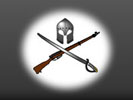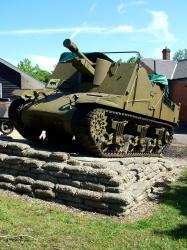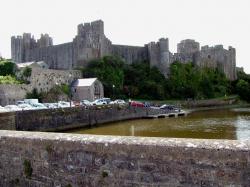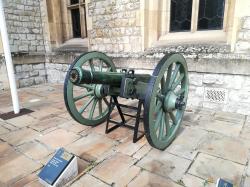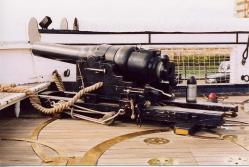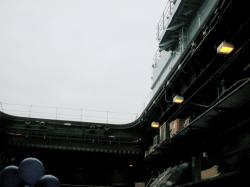Translate this Page
Trafalgar
Battle Name : Trafalgar
Date(s) : 21 October 1805
Part of : The French Revolutionary and Napoleonic Wars , French War of the Second Coalition ,
Outcome : A victory for The British Fleet [Royal Navy] over Combined Fleet [French and Spanish]
Type of battle : Sea
Summary
Napoleon Bonaparte had planned an invasion of England which required control of the English Channel. To achieve this he had to defeat the British Fleet. The combined Franco-Spainish fleet under the command of Vice-Admiral P. Villeneuve attempted to implement Napoleon's plan. A fleet of 33 ships of the line plus five frigates met the British Fleet, 27 ships of the line plus four frigates, about twenty miles west of Cape Trafalgar. Vice-Admiral Lord Nelson ordered his ships into two columns which approached and cut into the Combined fleet's line head on at pre-determined points. The employment of these tactics on this scale was revolutionary, this plus the superior sailing and gunnery abilities of the Royal Navy gave the British a resounding victory.
Napoleon's plans to invade England were crushed.
Location
The area of the battle centred some twenty miles North West of Cape Trafalgar. At the end of the action the position was some 8 miles WNW of Cape Trafalgar. At the commencement of the action the sea was fairly calm and the wind was light from West by North West. By the evening of that day the wind was moderate West by South West. In the course of the next day the wind swung to the South and increased to gale force by the evening of the 22nd. The wind continued very strong for the next two days. (Atlantic)
More details
The strategic background was Napoleon's desire to invade England and the assembly of a French army at Bolougne. Invasion barges were under construction. What was required was a strong enough naval force to escort the army across the Channel. The ships were available in French and Spanish Mediterranean and Atlantic ports all of which were being blockaded by the British navy. On Napoleon's orders Villeneuve escaped from Toulon 17 Jan. 1805 but had to return on the 21st Jan 1805.
On March 30th Villeneuve again broke out of Toulon. His squadron consisted of four 80 gun ships, seven 74's and eight frigates. He avoided Nelson and entered the Atlantic on the 9th April. Late that day he made contact with Gravina in Cadiz and requested him to join up. Admiral Gravina had fifteen ships of the line.
Nelson was about a month behind Villeneuve's move and on the 14th May the British squadron of ten of the line and three frigates was at Madeira while Villeneuve was off Martinique.
After an unsatisfactory cruise around the West Indies Villeneuve headed back to Europe arriving off Ferrol on the 22nd July. Calder was on blockade duty and fought an action against the combined squadron which was at best indecisive. Calder's force, fifteen ships of the line, was four 98's, one 80, nine 74's one 64 and two frigates. The larger combined fleet, twenty ships of the line, was one 90, five 80's, twelve 74's, two 64's and seven frigates. Calder captured two Spanish ships and inflicted more damage than he sustained but Villeneuve gained the port of Vigo from where he could make for the Channel or the Mediterranean.
Meanwhile Nelson had also re-crossed the Atlantic and in better time than his enemy. He made for Cadiz and there linked up with Collingwood. Nelson arrived at Gibralta on the 20 July. He disposed his squadron in part to protect Malta and in part to reinforce Collingwood. Then he took Victory accompanied by the frigate Superb back to England.
Villeneuve moved the combined squadron from Vigo to Ferrol where he linked with further Spanish ships. His strength was now thirty of the line. He then left Ferrol on the 13th August attempting to reach Brest in line with Napoleon's orders. A strong north-easter forced him to take the fleet back into Cadiz where he arrived on the 20th August. Collingwood with a ten to one disadvantage could do nothing to prevent this so he retired to a safe distance and despatched Blackwood to England with the news. Villeneuve now had the addition of the ships which had been blockaded in the port and Collingwood's assessment was that there were now a total of thirty six ships of the line in Cadiz.
Cornwallis detached Calder's squadron to reinforce Collinwood.
Nelson in the Victory left Porstmouth on the 14th September 1805 with Euryalus as consort. On the 17th he picked up Ajax and Thunderer off Plymouth.On the 25th he was off Lisbon and on the 28th he joined the fleet and took over command from Vice-Admiral Collingwood.
As yet unbeknown to the British Napoleon had abandoned plans to invade England and on the 18th September 1805 he ordered Villeneuve to sail for Naples to land troops in Italy. Villeneuve made preparations to obey this order.
During September and into October ships were joining Nelson's fleet Defiance, Royal Sovereign, Agamemnon and Africa all came in before the 14th October.
On the 18 October Villeneuve issued orders to prepare to weigh and on the 19th the combined fleet began to set out from Cadiz. The first seven ships under Rear-Admiral Magon de Médine were ordered to destroy or capture Blackwood's squadron but the ever alert Blackwood could not be caught.
Nelson had posted the frigates close in and set up a chain of battleships to relay their messages. By 0930 on the 19th October 1805 Nelson was aware that the combined fleet was coming out. He was at that time some fifty miles out to sea. Because of the light winds it was only late in the day that the whole combined fleet was able to clear the harbour. They then steered a course to the north-west and Nelson took a parallel course. At about 1400hrs on the 20th October the combined fleet turned onto a southerly course but Nelson continued northerly until 2000hrs when he too turned south. Both fleets stayed on a southerly course all night. During that night the combined fleet was ordered to come into a single line of battle which by daylight was 'a curve convexing to leeward' [Collingwood].
At 0400hrs on the morning of the 21st October 1805 Nelson ordered his fleet to stand north by east. This manoeuvre placed him at daylight nine miles to windward of the enemy . Just before six o clock the Combined fleet was visible to Nelson as they were silhouetted against the dawn sky. Nelson had planned, with his Captains, to approach the enemy in two columns. He had correctly assumed the enemy would follow the orthodox plan of forming a single line of battle. Nelson's two columns would cut the enemy line at one third of the way and two thirds of the way from the lead ship. This would give the British local superiority over the centre and the rear. The van would not be engaged and would take some time to get round and back to assist their comrades, especially in the light winds of the 21st October. Nelson hoped that this time would be long enough for his ships to have inflicted significant damage on those with which they had been engaged.
Over the night of the 20/21st October 1805 the Combined fleet formed what became almost in a single line four to five miles long gently curving with the head pointing NNW and the tail SSW. There was a significant gap, almost a mile, between the sixteenth ship, San Leandro, and the seventeenth, Indomptable. At the start of the engagement a probable order (authorities differ) of the Combined fleet was:Neptuno [Sp], Scipion[Fr], Intrépide [Fr], Formidable [Fr], Mont Blanc [Fr], Duguay Trouin [Fr], Rayo [Sp] some way to windward of the line, San Francisco de Asis [Sp], San Augustin [Sp], Heros [Fr], Santisima Trinidad [Sp], Bucentaure [Fr], Redoubtable [Fr], San Justo [Sp], Neptune [Fr], San Leandro [Sp], Indomptable [Fr], Santa Ana [Sp], Fougueux [Fr], Monarca [Sp], Pluton [Fr], Algeciras [Fr], Bahama [Sp], Aigle [Fr], Swiftsure [Fr], Montañes [Sp], Argonaute [Fr], San Ildefonso [Sp], Argonauta [Sp], Achille [Fr], Principe de Asturias [Sp], Berwick [Fr], and San Juan de Nepomuceno [Sp]. Thirty three ships of the line.
The wind was light, 4 to 6 knots, from approximately WNW.
The British fleet's position was due West of the enemy line and their course was about ENE converging with the enemy. The two columns Nelson had ordered were about a mile apart. The more northerly column, often called the weather column or the windward column was led by Vice-Admiral Nelson in the Victory. The more southerly, or lee, column was led by Vice-Admiral Collingwood in the Royal Sovereign. The ships of Nelson's column, in sailing order, were: Victory, Téméraire, Neptune, Leviathan, Conqueror, Britannia, Ajax, Agamemnon, Orion, Minotaur, Spartiate, and Prince. Collingwood's column consisted of: Royal Sovereign, Belleisle, Mars, Tonnant, Bellerophon, Colossus, Achille, Revenge, Defiance, Polythemus, Dreadnought, Swiftsure, Thunderer, and Defence. The 64 gun Africa was alone about two miles due north of Victory. The total gun difference was an advantage of 2622 to 2148 in favour of the Combined fleet but this Nelson planned would be annulled by the British tactics.
With the wind being so light the British, even with studding sails set, were only moving at two to three knots and took a long while to close with the enemy. The lead ships of the two British columns came under heavy fire as they approached without being able to return broadsides.
Just after twelve-o-clock Collingwood in Royal Sovereign [100 guns] broke through the enemy line by passing close under the stern of the Santa Ana [112 guns] firing every gun of her port broadside into her as the guns came to bear. At the same time Royal Sovereign fired her starboard broadside into the Fougueux and then took station on the starboard bow of the Santa Ana. Royal Sovereign was engaged by San Leandro, Fourgueux, San Justo and Indomptable until other British ship came up into the action. Just after two-o-clock the Santa Ana struck her colours.
The Bellisle, second ship in the column, also fired on the Santa Ana and the Fougueux. After exchanging broadsides with the Indomptable she became engaged with the Fougueux for an hour. The Fougueux had previously raked the Mars.
The weather column now cut into the line with Victory, having taken considerable punishment while closing, passing under the stern of the Bucentaure. While passing the stern Victory fired her carronades into the cabin levels and her double shotted broadside down the length of the ship as each gun came to bear.
The battle began to resolve itself into three sections. The Combined fleet's van under Dumanoir, [Formidable, Duguay Trouin, Mont Blanc, Scipion, and Neptuno] having been engaged by the lone Africa, began their attempt to get round and back into the battle. Collingwood's fifteen ships engaged ship from the rear and Nelson with twelve ships engaged the centre. The whole action broke down into a number of mini battles whose composition varied from one ship on one ship to one ship [e.g. Bellisle] exchanging fire with as many as ten of the enemy sequentially or to one ship [e.g. Royal Sovereign] against five opponents at the same time.
The individual ship actions are noted against their unit names as are the fates of the ships of the Combined fleet.
According to Victory's log 'partial firing continued until 4.30pm'. At that time the British were in possession of 17 of the enemy ships and the French Achille had blown up. Fifteen of the Combined fleet had escaped into Cadiz. None of the British had been taken or destroyed but many were in a perilous state as were most of their prizes. The wind had been gradually increasing in strength as the afternoon wore on.
The battle is significant for the death of Viscount Nelson, who lived long enough to know that his tactics led to the triumph of his 27 ships against the 33 of the Combined fleet.
The storm on the 22nd October and the massive damage done to so many ships lead to the loss of most of the prizes, and of those that were saved few were fit to enter service. A sortie on the morning of the 23rd lead by Commodore Kerguelen in Pluton [74]. Five line of battle ships and five frigates. They retook the Santa Ana and Neptuno, got the first safely back into Cadiz but the second drove ashore off Rota.
The most immediate consequence was that Napoleon abandoned any hope he had of invading England. Lord Barham's forecast that 'I do not say they shall not come, I only say they shall not come by sea.' was proved to be accurate. Further to this the facility to move the French army and to keep it supplied along the coast of countries it was occupying, particularly in the Mediterranean, was denied them. France was confined to a land war, supplies from her overseas colonies were denied her, and a close blockade was enforced.
The longer term effects of the battle, containing as it did both a victory and the death of a national hero were immeasurable but immense. The Victorian and later schoolrooms imbued a nation with the myths and legends of the Thin Red Line, The Charge of the Light Brigade and Nelson's signal at Trafalgar. The Nelson Spirit in particular was invoked, collectively by fleets and crews and by individuals within themselves, during naval engagements both great and small. When Harwood took his cruisers against the Graf Spee and when the Amethyst broke out from the Yangtse, Nelson was there, and England was expecting every man to do his duty..
Casualty figures
The British Fleet [Royal Navy]
- Number engaged :
- n/a
- Casualties :
- n/a
Combined Fleet [French and Spanish]
- Number engaged :
- n/a
- Casualties :
- 10,742
